Si-Tex SP36 autopilot, like ComNav’s but different
My first reaction to a press release about the new Si-Tex SP36 autopilot — sure to be posted at the Si-Tex site soon — was that its nifty-looking color control head above looks exactly like one ComNav has offered for a while. Not that rebranding the ComNav gear, which has a good reputation (I think), is a bad thing. But what’s actually going on here is that Si-Tex has contracted ComNav to manufacture an autopilot to its own specifications, and at least one difference looks like a smart idea to me…
Si-Tex has also gotten Airmar to build it a custom version of the H2183 compass that Dan Corcoran has become so fond of. It’s called the Si-Tex HDK-11 and the SP36 autopilot is designed to work with it. In fact, according to Si-Tex, this is the only autopilot that can calibrate Airmar’s high performance sensor directly, which means that an owner or installer won’t have to mess with Airmar’s Weather Caster software (unless they want to). And while Si-Tex and ComNav use the sensor’s NMEA 0183 port for their autopilots, its NMEA 2000 port will be available for other uses. Si-Tex will even offer an optional NMEA 0183 to 2000 adapter so that the SP36 can further integrate with a mostly N2K vessel. I’ll guess that it’s an Actisense NGW-1, and an owner or installer could get one to work on their own, but when a single supplier offers all the interface bits and pieces, and supports them, that’s a good thing.
I’ve had a look at the manual for the Si-Tex pilot, along with a similar one from ComNav, but I haven’t figured out what else is different about the SP36. They both look like pretty advanced systems, with virtual rudder feedback (if needed), ongoing performance improvement intelligence, the ability to perform maneuvers like the MOB turn below, and many more features. I understand that Si-Tex — which went through a big management change last year — has SP36 units in stock, at $3,300 with Virtual Feedback and HDK-11 compass, but without pump. Hopefully more info, manuals, etc. will be up on their site soon.


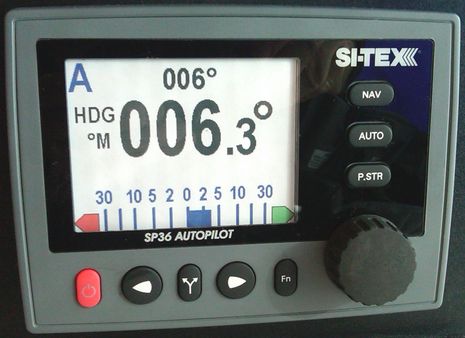
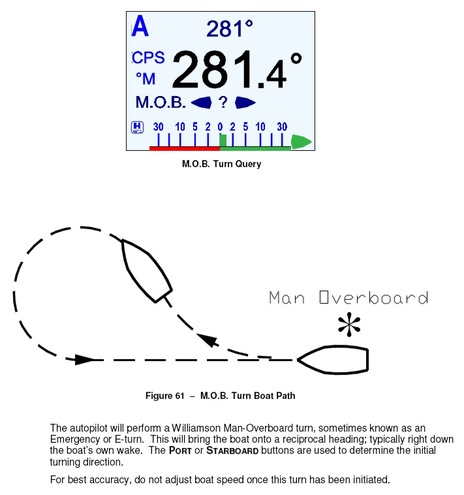
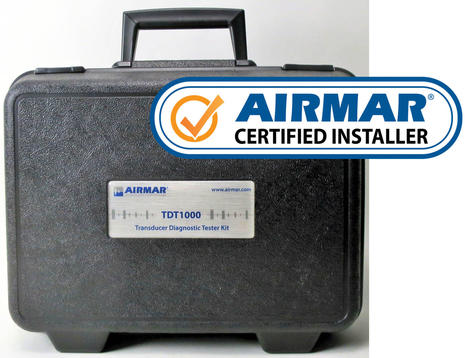
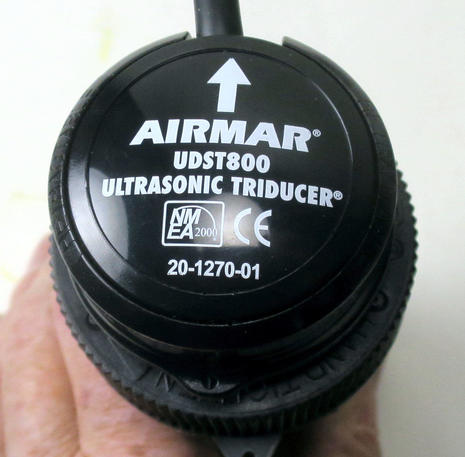

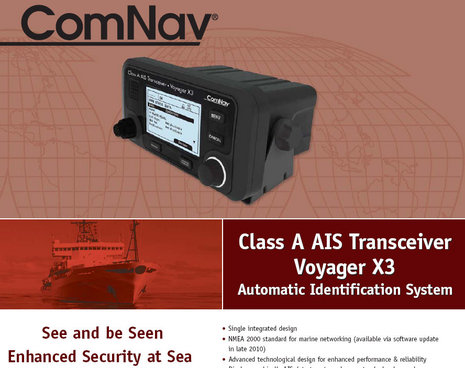







Integration of a 3-axis sensor is great, but possibly a bit misleading. We are increasingly surrounded by systems (including us) who can’t use all the information they are supplied.
Effectively applying pitch and yaw data to determine how to adjust the rudder to hold a steady course in a seaway is a difficult problem, particularly with the variety of hull shapes that must be considered. Of course they’ll know if they’re starting with a motor or sailing yacht, but there is so much more to the problem, ask any naval architect, or watch any world class helmsman at work.
Like most devices these days, the hardware is only an interesting as the software running it (imagine an iPhone running Windows Mobile!). I’d like to read a long press release from Si-Tex (or any other manufacturer except maybe NKE or B&G) about the investment they’ve made in the software controlling the autopilot and how it applies this data.
I have the ComNav ComPilot for a few years now. Looks identical to the picture here. There is one chronic issue that needs to be corrected. Condensation forms under the display head glass and after two rebuilds by ComNav a replacement and supposedly new sealant used I still have the condensation problem, (although less then before). I gave up on getting this fixed and decided to live with it. The ComPilot works great. I abandon the ComNav fluxgate compass and “Rate compass” add-on for the Airmar H2183, N2K/0183 compass. This made a very noticeable improvement in straight-line tracking.
My few operational complaints are the difficulty of switching from day display colors to night colors. If you don’t make this change you will be blinded by the very bright color display at night. One has to go into a menu, scroll down and select from several colors and then select backlighting intensity. This operation should be a one button push. In fact, this is a big complaint I have with the Garmin GMI-10.
Although “NMEA2000” is listed in the ComPilot’s menu it is not implemented. Seems to me ComNav started down the right road of creating the first NMEA 2000 autopilot and gave up, but never took the NMEA 2000 out of the menu. Too bad, they missed being the first when it would have made a difference. (Ref:according to tech support)
ComNav rarely issues a software or firmware upgrade, however, when they do it requires the unit be shipped back to the factory for re-programing. This is primitive by any standard and expensive to ship to Canada. What’s wrong with letting the end user hook-up a USB cable and load an update?
I hope Si-Tex found these few issues and insisted on improving them in their version if it is manufactured by ComNav. In any case, the ComPilot does everything I need it to do on a sailboat and has many fantastic features for workboats as well.
Outstanding, I am a big believer in yaw sensors improving autopilot performance. In the case of the Raymarine autopilots like the S1, I have noticed a considerable improvement with a yaw sensor (Raymarine SRS option) especially in following seas. It’s almost like magic, as it seems to anticipate each wave and turn the wheel in a manner that keeps my boat perfectly straight.
A solid state compass is so much more responsive and accurate than a fluxgate. It quickly reports course changes, settles down after course changes instantly, and provides super accurate heading information that makes calculations like set and drift useful. (see my earlier article)
Just as implemented here, the H2183 gives you not only an option of protocol outputs but an option of dedicating an output (off network) to the autopilot (the NMEA-0183 output) with a second output for your network (NMEA-2000). It is exactly like dedicating the compass to the autopilot, which the autopilot makers like, without the headache for the boat owner of having a second heading source providing different heading information on your helm as would happen if you mix fluxgate and solid state compasses on your boat.
A wild guess here, but I would imagine one of the customizations made to this H2183 is to insure thru cabling that the NMEA-0183 output is dedicated to the autopilot and maybe as well powered from the autopilot rather than the NMEA-2000 network, so it’s completely independent of the NMEA-2000 network connection.
Note, the H2183 standalone can be calibrated without a PC and WeatherCaster. Rotate the compass in its nifty mount to get the offset to zero, and follow the provided instructions to trigger the calibration procedure (e.g. turn boat in circles). The heading value provides status during the calibration. Even so, I suppose it is useful to have your autopilot display having calibration control at your fingertips especially if you installed your sensor in a hard to reach area.
Dan – Could you please expand on that Raymarine SRS option? I have the X30 which I believe is the latest greatest Raymarine pilot. The only feature that sounds like SRS is the “smart rudder sensor” that relates to elminating the rudder sensor, but isn’t applicable to sailboats. Raymarine claims that their gyro enabled course computers sense yaw through their internal gyro.
I believe the yaw data would be in the ROT sentence, but the Raymarine autopilots do not accept that sentence. Before considering the H2183 I’d like to be confident that my autpilot would actually use the data.
Russ:
#1 SRS Question: Opps, typo, should have wrote SHS – Smart Heading Sensor (also called a Pathfinder Smart Heading System and sometimes a Gyro 2). SHS is essentially a gyro in an external box that you add to an S1 autopilot to upgrade it to the functionality of an S1G autopilot. (beware the instructions are entirely incorrect, contact Raymarine support for correct wiring)
http://www.raymarine.com/ProductDetail.aspx?SITE=1&SECTION=2&PAGE=389&PRODUCT=699
#2 Autopilot / ROT Question: Russ, you can leave your fluxgate in place and just add the H2183 to your boat network.
All the Raymarine displays and MFD’s, sans the autopilot control head, will helpfully display the new more accurate H2183 heading source. If your using 0183 to get fast heading information from your autopilot to your MFD (to improve MARPA), you will need to either wire the MFD instead to the H2183 instead of the autopilot, or put both the MFD and the H2183 on NMEA-2000. (for the benefit of other readers, fast heading is not supported by the original seatalk protocol). See this post on the benefits of adding the H2183 to your boat, http://madmariner.com/blog/ben_ellison/39546
Richard C: I have to respectfully take issue with your mention of the Comnav as potentially the first NMEA2000 AP. Indeed, I have a 4-year-old Simrad AP25 that is using a Furuno SC30 as heading source (via a N2K connection from a NavNet 3D black box) and is outputting rudder angle data to my GMI 10s via N2K as well.
However, I completely agree with you about display dimming being something that should be a single button press. The GMI 10 requires four “clicks” just to get to the brightness setting screen and then a bunch of presses to change from full bright to dim enough for night running.
Even PC plotter app developers don’t all do this right (but you do, Rose Point): in MaxSea TZ you need to go into the options screen, choose the “General” tab, and then click a drop-down for Day/Night Mode. And there is an “automatic” option that you’d think would take time of day and sunrise/sunset into account but in fact doesn’t seem to do anything.
/afb
Dan- The gyro is built into the current Raymarine autopilots. And the X30 won’t accept the ROT sentence, so I don’t think adding the H2183 will enhance the performance of any of the Raymarine X autopilots. As you point out it will assist the earlier “non G” Raymarine pilots.
My Furuno MFD uses the PG500 heading sensor which is (I think) just a fluxgate, but does have fast heading output to the MFD for MARPA. New Morning has both the PG500 for the MARPA, and the Raymarine fluxgate for the autopilot.
With regard to Ben’s article, my response to accuracy is that if I’ve effectively got ROT in my autopilot, then it’s steering me where I want to go. A 1-2 degree difference in MARPA is not meaningful, I want to clear the ship by a lot more than 1-2 degrees!
More accuracy is a good thing, but given the long list of “improvements” competing for my boat budget, improving my heading accuracy by less than 1 degree is not compelling. So I don’t see the after market as being viable.
But in the context of a new MFD/MARPA/Compass installation, certainly the Si-Tex/Airmar product raises the bar for those that include just a fluxgate compass.
Hi Russ,
The PG500 has a rate gyro inside it to stabilise the output
Andy
Andy – Great!
So with a gyro in the PG500, and a gyro in the Raymarine X30, what advantage would be gained by adding the H2183?
Or to put the question in the opposite context, which equipment will accept the ROT sentence and benefit from the yaw data?
Hi Russ,
I believe NN3D will accept rate of turn data but tbh its hardly worth throwing out a good rate compass for one extra sentence that very few bits of kit actually use.
(Note just because NN3D accepts ROT doesn’t mean it uses it, its possible it just displays it on screen etc)
Pilot wise id say you had no advantage to gain unless you went down the GPS compass route (SC30 + autopilot = very straight course)
One thing i noticed with some pilots if its possible to set the NMEA rate on the raymarine to high speed (38400 baud) do so and set the output of the PG500 to 25hz as this has improved the pilot on many installs i have done.
Also will improve your NN3D radar overlay and ARPA.
A